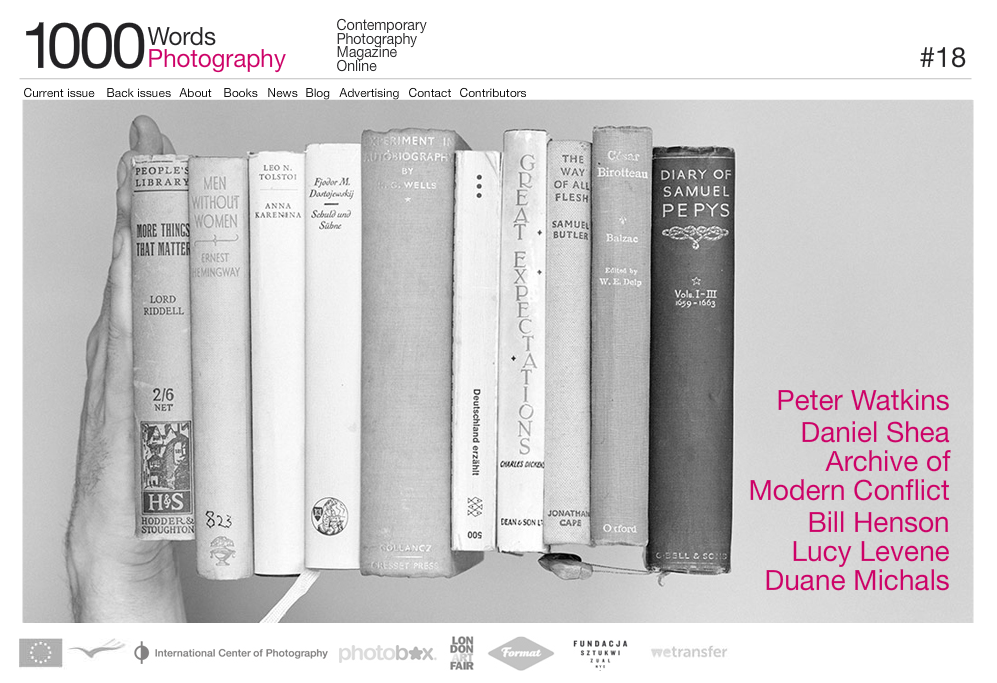Hot off the heels of our nomination in the ‘Photography Magazine of the Year’ category at the Lucie Awards 2014, we are delighted to announce the launch of 1000 Words issue 18. This is the last release delivered in the current format before we launch our brand new, fully responsive website in early 2015 so stay tuned for more details!
First up, is a series from one of the most interesting new talents to emerge from the UK photography scene in recent years, Peter Watkins. The Unforgetting is a powerful and moving examination of the artist’s German family history; the trauma surrounding the loss of his mother to suicide as a child, as well as the associated notions of time, memory and history, all bound up in the objects, places, photographs, and narrative fictions that form its structure. The work is accompanied by a text from Edwin Coomasaru, one of the curators of Watkins’ highly-acclaimed exhibition at the Regency Town House as part of the Brighton Photo Fringe 2014.
There is also a portfolio dedicated to another rising star, the American photographer Daniel Shea. Renowned writer and founder of Errata Editions Jeffrey Ladd sits down with Shea’s recently released photobook, Blisner IL and finds much to celebrate in its pages. This new edition explores the post-industrial fallout of a once prosperous albeit imaginary Southern Illinois town. It offers a reality woven from an assembly of disconnected locations – all with their own lineage and history – then it lends itself as a surrogate to comment on that larger state of a country where globalisation and demands of economy have long shifted from production.
Elsewhere, we showcase a remarkable set of images from Cameroon’s earliest colour photo studio Photo Jeunesse, now part of the endlessly fascinating collection of TheArchive of Modern Conflict. As independent curator and academic Duncan Wooldridge notes, the material represents a record not only of Cameroonian society, tracing tradition and globalisation but in its loose ends – the details of its painted sets, and the playful activities of its sometimes quirky sitters – it tells an alternative story of the photo studio, and its ability to represent not only the formal and dignified version of the sitter, but the very excess that surrounds them. The photographs were premiered back in November during Lagos Photo Festival, Nigeria.
One of Australia’s most celebrated photographers Bill Henson gets his dues in our review of 1985, his latest book designed by The Entente and published by Stanley/Barker. “Henson’s camera has the ability, through movement and then poise, to render the best kind of sombre confusion,” writes Daniel C Blight in his paper. “Henson’s images are subdued not in time, but overskies and through buildings, clouds, naked people, telephone pylons, pyramids and other familiar or extraneous abstractions. They are seemingly underexposed, but we can’t call them badly lit. Somewhere between the ambiguity of eventide and its gloaming opposite, Henson is a wonderer; one whose images intentionally do whatever they can to avoid stasis and perhaps clarity, within the confines of their static medium.”
In a different feature brought to you by the The Photocaptionist Federica Chiocchetti, we take a look at The Spaghetti Tree by Lucy Levene, a documentary study of Bedford’s Italian community, the largest concentration in the UK at more than 14,000 people. Attending events and accepting invitations to people’s homes, she developed attachments and became involved in the families’ intimate narratives. Her often witty photographs call into question mythologies of what it means to be ‘Italian’ and the nostalgic ideal of ‘La Bella Figura’ felt by many as they try to forge an independent identity in their new home, simultaneously revealing the tensions in conventional modes of portraiture; the perfect and imperfect image.
Finally, we send a dispatch from The Carnegie Museum of Art, Pittsburgh, United States on the occasion of
Duane Michals’ huge retrospective exhibition, Storyteller: The Photographs of Duane Michals. Aaron Schuman provides a stirring essay, questioning how the artist has influenced contemporary practice in reference to the current fashion for art-and photo-historical referencing, appropriation, and photomontage, as represented by emerging photographers such as Matt Lipps, Brendan Fowler, and Anna Ostoya. His analysis also takes in the lessons to be found in Michals’ work, from the distinct power of photographic sequencing, soul-searching, sincerity, and storytelling as evinced by leading practitioners such as Alec Soth, Paul Graham and others.Over in our dedicated Books column, Lewis Bush leafs through The Bungalow by Dutch artist Anouk Kruithof, which offers an engaging and individual look at the evolving nature of photography via images from Brad Feurhelm’s esoteric vernacular photography collection; Tom Claxton of Webber Represents opens the lid on Laia Abril’s much celebrated The Epilogue, at once a testimony and posthumous biography of the life of Cammy Robinson, who died at 26 as a result of bulimia; and David Moore discusses the merits of Studio 54 by the great but somewhat under appreciated Tod Papageorge.
SOURCE: 1000 Words Photography Magazine Blog – Read entire story here.
